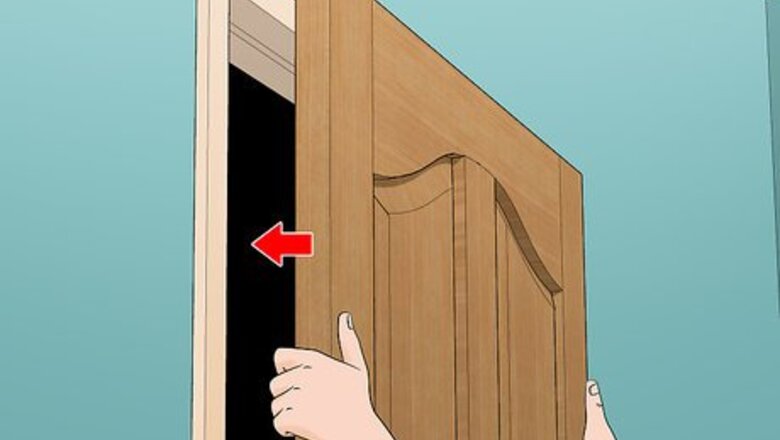
views
Fitting the Door in the Jamb
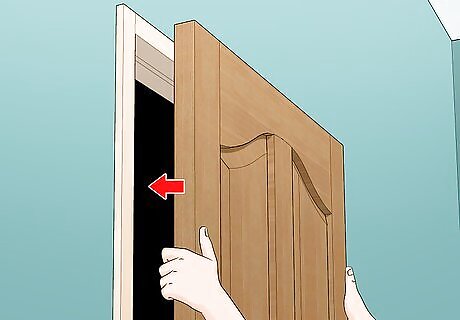
Stand the door up in the existing frame. Lift the door up and fit it into its frame as best as you can. Make sure the bottom of the door sits flat and level on the ground so you can make an accurate measurement later on. If the door sits crooked, put shims underneath the sides until it is level. If the door is heavy, have a partner help you lift the door.

Measure the distance between the top of the door jamb and the top of the door. Use a tape measure to find the distance between the top of the door frame and the top of your door. Check your measurement in 3 different places across the top of the frame to make sure the distance is the same. If the measurements are not the same in each of the 3 places, use 40-60-grit sandpaper to smooth out the surface.Tip: If you're replacing an old door, then you can use the older one as a template for measurements. Clamp the doors together and mark the height, as well as where the hinges are.
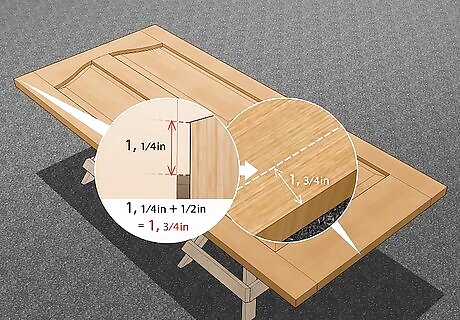
Cut the bottom of the door using the measurement you took. First, add ⁄2 in (1.3 cm) to the distance between the top of the door and the door jamb. Then, measure that distance up from the bottom of the door and mark it, putting a layer of tape above the mark so the wood doesn’t splinter when you saw it. Next, set your door across 2 saw horses, and use clamps to secure the door in place. Finally, use a circular saw to cut off the bottom portion of the door along the mark you made. For example, if you measured 1 ⁄4 in (3.2 cm) on the top of your door, cut off 1 ⁄4 in (4.4 cm) from the bottom of the door. Wear safety glasses while working with your circular saw. If the difference in height is less than ⁄8 inch (0.32 cm), use a 40-60-grit sandpaper or a planer. Use a finish saw blade with teeth packed close together to get a smooth cut without splintering.
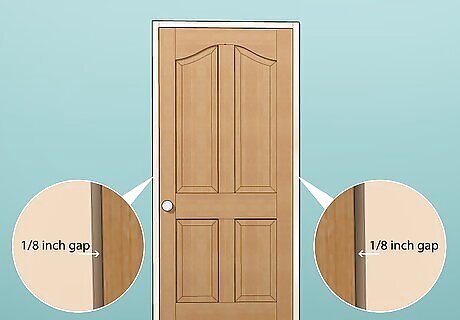
Check the measurements on the sides of the door. Hold the door in its frame so it’s pressed against the hinge side, and check how it fits. Make sure there’s at least ⁄8 in (0.32 cm) of space between each side of the door and the frame. If the door doesn’t fit, take 3 measurements along 1 side of the door. If the door fits well, you can skip to attaching the hinges. Check the width measurement from the door jamb to ensure that it's accurate.
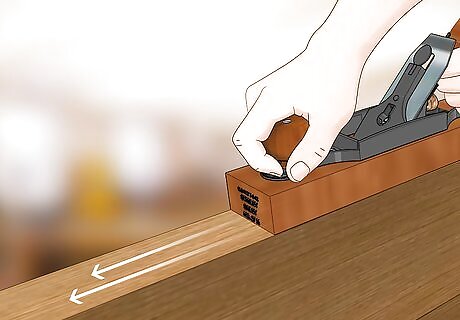
Sand or plane the sides of the door if you need to. Remove an equal distance from each side of the door. Use a 40- or 60-grit sandpaper to shave down the sides of the door until it fits in the frame. To remove more than ⁄8 in (0.32 cm), use a planer to scrape the wood off. For example, if your door is ⁄2 in (1.3 cm) too wide, then remove ⁄4 in (0.64 cm) from each side.
Attaching the Hinges
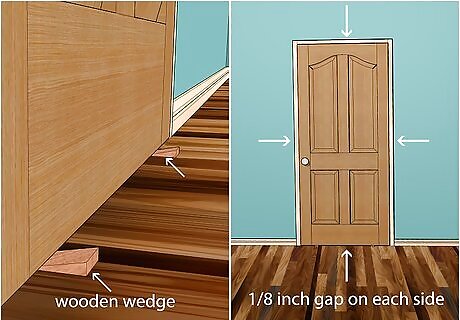
Stand the door in its frame with wooden wedges. Once the door is trimmed to size, place it back in the frame. Position wooden wedges underneath the door so you have at least ⁄8 in (0.32 cm) between each side and the frame. If you don’t have wedges, you can use ⁄8 in (0.32 cm) shims instead.
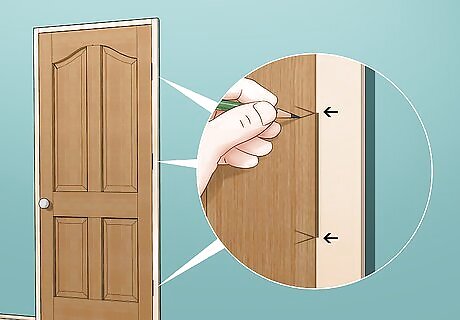
Mark the top and bottom of each hinge on the door. Use a pencil to draw a line where each of the hinges was on the frame. Make sure to mark the tops and bottoms of all 3 hinges so you know exactly where you need to make the mortises, or hinge wells, on your door. Make sure the side of the door with the knob is on the opposite side as the hinges.
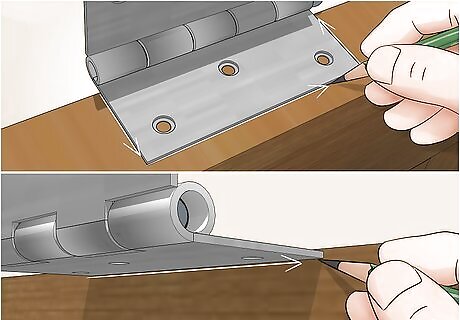
Trace the shape and depth of the hinges onto the door. Take the door back out of the frame and set it on your saw horses. Hold your hinges on the side of the door so they’re in between your marks. Trace around your hinge to get the correct shape for your mortises. Hold the edge of your hinge on the front of your door and mark the depth. Draw your pencil marks lightly so you can easily erase them.
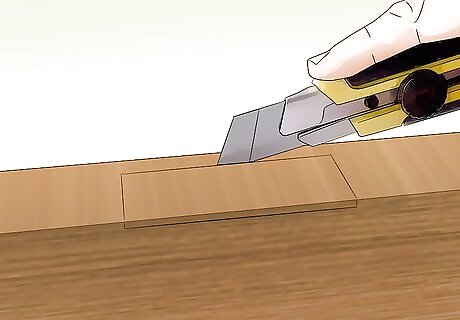
Score the outlines with a utility knife. Set your hinges down, and follow along the line you drew with a sharp utility knife to begin your cut. Use a straightedge to ensure that you don’t make a crooked cut. Trace along all 3 hinges with your knife. Stay inside of your pencil lines so you don’t accidentally over cut.Tip: If the utility knife doesn't make deep enough cuts, you can use the sharp end of a chisel instead.

Make a series of cuts with a chisel on the side of the door. Hold the chisel in your non-dominant hand so the blade is at a 45-degree angle to the side of your door. Pound the end of the chisel lightly with a hammer to make a small cut for your mortise. Continue making cuts ⁄8 in (0.32 cm) apart across the length of each mortise. Make sure to only chisel to the depth of your hinge, or else you’ll remove too much wood. Sharpen your chisel so you don’t accidentally crack the wood.
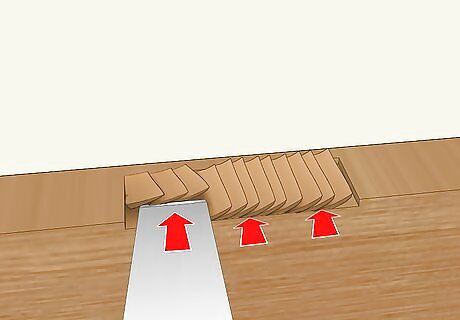
Clean out the mortises with your chisel. Place your chisel on the depth mark on the front of your door. Gently tap the end of your chisel with your hammer to chip out the pieces of wood in each of your mortises. Work from the center of each mortise towards the corners. Make sure the flat side of the chisel faces the door so it doesn’t splinter or break.

Screw the hinges into the mortises. Hold the hinge in the mortise so it fits tightly. Use an electric screwdriver and the screws provided with your hinges. Work slowly so you don’t crack or splinter your door.
Securing the Door
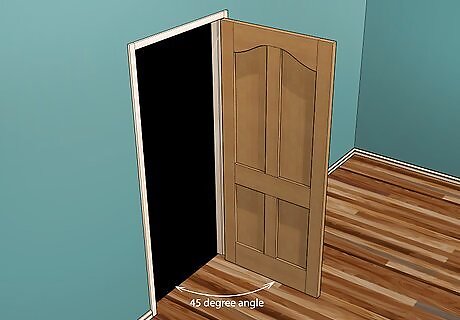
Use wedges or shims to hold the door in the frame at a 90-degree angle. Keep the door in an open position so you can attach the hinges to the door frame. Slide wedges or shims underneath the door so the hinges line up with the mortises on the frame. If the door is heavy, have a partner help you hold it in place. Make sure the door opens in the right direction before securing it to the wall.
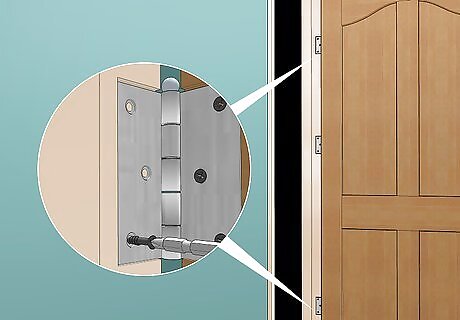
Screw the top and bottom hinges into the doorframe. Use an electric screwdriver to connect the top screws of the top and bottom hinges. Put the bottom screw in the top hinge to help support the weight of the door. Wait to put the rest of the screws in your hinges. If your door is heavy and starts to sag when you let go of it, put all 3 screws in your top and bottom hinges.

Close the door to make sure it fits in the frame. Shut the door completely to see if it closes securely. If the door doesn’t fit, then take it off of its hinges again and use a planer to shave off any excess wood on the side of the door. Use a 40- or 60-grit sandpaper if you have less than ⁄8 in (0.32 cm) to remove.
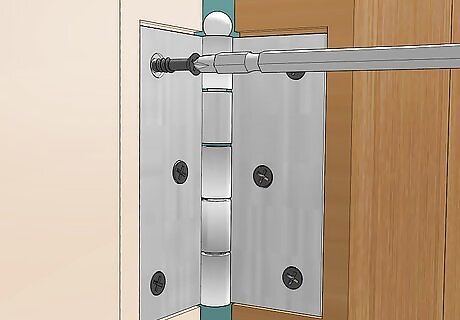
Attach the rest of the screws once the door fits. Use an electric screwdriver to attach the hinges to the door frame. Start by putting the remainder of the screws in the top and bottom hinges before securing the middle hinge. Once the door is secure, test it again to make sure it opens and latches shut. If so, then your door is ready to use!



















Comments
0 comment